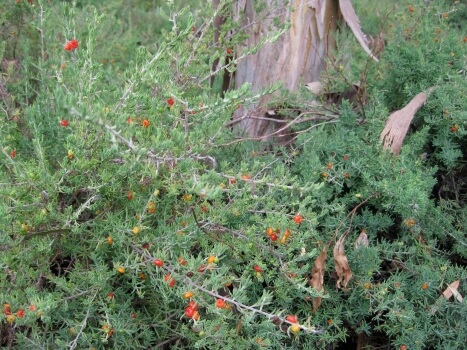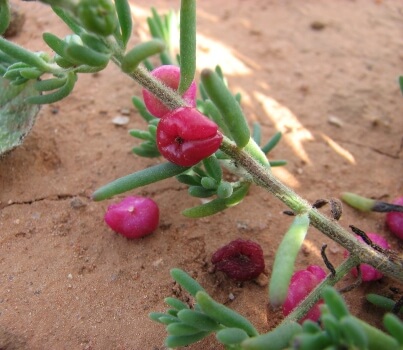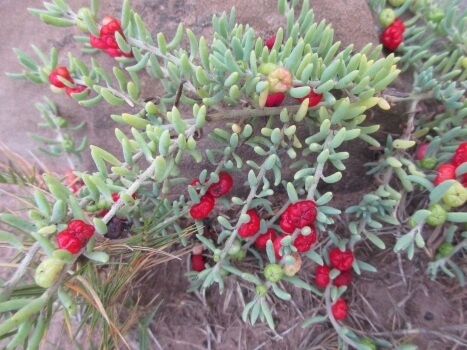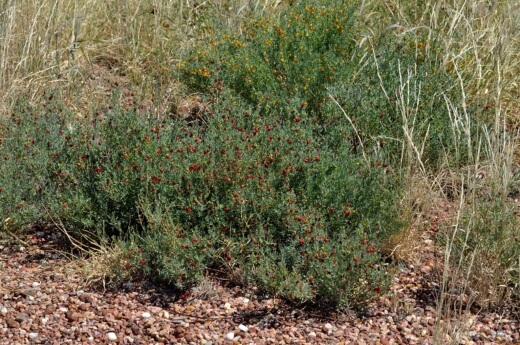Our beloved Ruby Saltbush is a charming and whimsical low-growing shrub prized for its fleshy green foliage and its decorative edible berries, making it a notorious bush tucker species as well.
It is a semi-succulent, native perennial shrub that features a highly-branched, dense and compact growth habit, perfect for filling out tough spots in the garden in addition to many other superb landscaping applications.
Easily elevating outdoor spaces with its silvery-grey foliage and brightly coloured fruits, this hardy and woody species can also flower and fruit throughout the year so it’s no wonder it is gaining such popularity across the continent. Here is your guide to growing and caring for this outstanding bush tucker.
More...
Family: | Amaranthaceae |
|---|---|
Genus: | Enchylaena |
Species: | E. tomentosa |
Common Names: | Ruby Saltbush, Barrier Saltbush |
Origin: | Native |
Location: | Outdoor |
Type: | Small shrub |
Growth: | 0.4 to 1 metre tall, 0.5 to 1 metre wide |
Sun requirements: | Full sun to light shade |
Foliage Colour: | Green |
Flower Colour: | White to green (insignificant) |
Flowering: | Spring, summer, autumn |
Fruit: | Produces small edible berries |
Maintenance level: | Low |
Poisonous for pets: | Foliage is toxic to cats and dogs |
Getting to Know the Ruby Saltbush Plant
Slender, cylindrical succulent-like leaves sit atop dense and wiry stems, both of which are covered in fine woolly hairs, inducing the plant's silvery charm. The ornate fruits form as fleshy berries, offering wonderful flushes of summery greens, yellows and reds as the fruits ripen at different periods in the year.
Enjoy a dense and spreading growing habit with this useful bush tucker. Botanically labelled Enchylaena tomentosa, this plant is commonly known as ruby saltbush and barrier saltbush. Traditionally it is named Kurrkuty (Wemba Wemba).
This Australian native is endemic throughout the continent, occurring in every state across the mainland, naturally being found in the saltmarshes of our tropical, subtropical and temperate regions.
Part of the Amaranthaceae family of plants, this species has naturalised itself to a very wide range of soil types and climate zones.
(Also, see our guide to growing mulla mulla, which comes from the same family of plants.)
Being a well-adapted and highly resilient shrub overall, it will make for an excellent addition to any Australian garden. Common uses include gap filling, groundcover, coastal gardening, undergrowth beneath shady trees, pot and container gardening, or low-growing hedging and screening.
How to Grow Ruby Saltbush

Source: Grasslands
In gardens, Enchylaena tomentosa will reach about 0.4 to 1 metre tall and 0.5 to 1 metre wide with a spreading habit. It is considered slow-growing in poor soils but this can be boosted with occasional watering and fertilising.
This species will perform well grown in pots and containers. It will fruit from year 1 onwards and will attract birds, bees and other beneficial insects.
Propagating Ruby Saltbush Plant
Ruby saltbush plant can be propagated using seeds or stem cuttings.
Propagating Ruby Saltbush from Seeds
We recommend purchasing healthy seeds from reputable seed retailers online or in-store. Seeds physically collected from these shrubs are not always viable as they naturally germinate from animal excrement once digested.
- Seeds should be sown in spring or autumn outside of the hottest and coldest months of the year.
- Soak the seeds overnight then remove the flesh from the seeds before sowing.
- Prepare well-drained seed containers or a punnet filled with a quality seed-raising mix.
- Sow the seeds about 4-5mm deep then gently water them using a fine mist spray.
- Place the seeds in a warm shaded or semi-shaded location.
- Keep them warm and moist. Avoid drying out or waterlogging the growing mix.
- Ideal germination temperatures are between 18°C and 22°C.
- Germination should occur within 2 to 4 weeks in the right conditions.
Propagating Enchylaena tomentosa Using Cuttings
Cuttings should be taken from a healthy parent plant. Softwood and hardwood cuttings should be viable.
- Using a sharp and sterilised pair of pruning shears, take healthy soft or hardwood stem cuttings that are around 8-10cm long.
- Remove the lower leaves from the cuttings then dip them at their cut end into some rooting hormone.
- Prepare a growing tray or container filled with a quality propagating mix then gently place the cuttings into the mix to a depth of about 5-7 cm or until firm.
- Lightly water the cuttings in then place them in a warm, sheltered position.
- Keep the growing mix moist as the cuttings develop.
- Transplant after about 1 year once the cuttings are stable, settled and producing ample new growth.
Planting Ruby Saltbush
While this shrub is very hardy and adaptable, certain conditions will ensure it thrives, fruits and flowers for as long as possible.

Source: Edible Eden Design
Ideal Soil Conditions
As mentioned, this shrub can tolerate a range of soils including sandy soils. However, it does prefer slightly saline soils, which is perfect for those who live in coastal areas. The soil should be moist with moderate to high drainage.
It is also beneficial to add some compost and organic matter to the soil before planting.
Sunlight Needs
Full sun is preferred for these shrubs to grow at a good pace, retain a bushy habit and flower and fruit prolifically. However, they can also grow in light to dappled shade, growth may just be slightly slower in these conditions and the shrubs may not produce fruits for as long.
Growing Ruby Saltbush in Pots and Containers
Ruby saltbush does well in pots. It will need to be kept in a sunny position on a balcony, patio or in the backyard. Always use a high-quality potting mix without any added additives or fillers. Instead, rather add your own native plant food for the best results.
Be sure to also always use well-draining containers. Water deeply then allow the mix to dry out before watering again. Prune potted shrubs regularly to maintain size and shapeliness.
How to Care for Ruby Saltbush
This native species is highly tolerant to drought and can also withstand frosts. A truly low-maintenance addition to the garden, this shrub will thrive with little care.
Watering
Water regularly when first planted. Once established after about 1 year, this shrub can tolerate long durations without water so only water supplementarily during dry spells. This species is sensitive to overwatering which can lead to rot.
Fertilising Barrier Saltbush
Fertilise in spring and autumn with a complete organic fertiliser for native plants. This will assist with fruiting and general plant vigour during these more active months.
Mulch Needs
Add an organic-based mulch like pine bark around the base of the shrub in summer to help retain soil moisture and suppress weeds.
Pruning
As with many fruiting shrubs, this species will also benefit from being pruned after fruiting has finished in mid to late autumn. Thin out the branches as well so the seedlings don’t take over.
For hedging and screening purposes, prune once the branches reach 30 cm tall to continuously encourage dense and outward growth.
For more native hedging options, check out our roundup of the best Australian native hedge plants.
Barrier Saltbush Pest and Diseases
There is very little reported data on this species suffering from any pest or disease issues. They do naturally attract many beneficial insects but they rarely cause any damage. No major plant diseases are known to affect this shrub.
Ruby Saltbush Bush Tucker Guide

Source: Wikipedia
This species produces highly decorative edible fruits that form as fleshy berries about 5mm to 8mm in diameter. The berries will start green then mature to yellow and finally turn red when ripe, offering wonderful displays and flushes of colour throughout the bush as the fruits ripen at different times.
The leaves are also considered edible but we recommend avoiding them. They are semi-succulent and can be harvested and consumed as a vegetable after being cooked or boiled. However, the leaves are very rich in oxalates so they need to be cooked thoroughly before you eat them and consumption should always be limited.
The shrub's drought tolerance allows it to produce fruits even in the drier times of the year like late summer to autumn, offering bush tucker enthusiasts long-lasting harvests.
Historically these fruits were sought after and picked by Indigenous Australians, early settlers and livestock as a snack food. The fruits are still frequently collected today. Children also used to pick them to make pink facial decorations.
How to Harvest Ruby Saltbush Fruits
- Pick the berry-like fruits once they have turned red and softened.
- Simply pluck them as needed from the main plant.
- Leaves can be harvested at any time of the year.
- Be sure to delay harvests for a few days after fertilising and always rinse fruits or leaves well before consumption.
How to Use Ruby Saltbush
- The berries can be eaten raw after being rinsed where they showcase a crisp texture and a salty-sweet flavour.
- The berries can also be steeped in water to make a sweetened tea or a refreshing cordial when cooled.
- The berries can make for great additions to salads or used as fruity additions to sauces, jams and other sweet or savoury preservatives.
- Leaves can be used after being cooked as a vegetable substitute in small quantities. Be sure to avoid eating the stems and just eat the fleshy cylindrical leaves.
There is unfortunately little nutritional information available for these fruits. They also do not store very well so try to only harvest what you need at any given time. As a general safety tip, always consume bushfood with caution and constraint in case you have any adverse reactions. In that case, stop all consumption immediately.
Ruby Saltbush Frequently Asked Questions

Source: Plants of the World Online
How tall is ruby saltbush?
These shrubs usually reach a maximum height of 1 metre tall and a spread equal to that. Container-grown plants will likely be slightly smaller.
What is ruby saltbush used for?
The berry-like fruits are typically eaten raw or soaked in water to make a sweetened tea or refreshing cordial. The shrub itself is great for filling out gaps in the garden or can make for excellent low-growing heading or screening.
What does ruby saltbush taste like?
The fleshy berries are said to have a wonderfully crisp texture with a salty-sweet flavour profile.
Is ruby saltbush native to Australia?
Yes, this species is native and is widespread throughout the continent, occurring in the inland areas of all mainland states and territories of Australia.
Is ruby saltbush an evergreen?
Yes, these shrubs are evergreen, perennial plants that can fruit throughout most of the year in optimal conditions.
What is the best soil for ruby saltbush?
Though these shrubs can tolerate many soil types, rich and loamy soil that is free-draining will work best.
If you’re interested in learning more about some of our most popular native fruiting species, be sure to check out our full catalogue: Aussie Green Thumb: Native Fruits
Raise Your Gardens Fruiting Spectacle with Ruby Saltbush
A truly ornamental bush tucker, ruby saltbush can provide gardens with long-lasting flushes of decorative fruits boasting an array of colours from green to yellow and finally red.
The luscious evergreen foliage of Enchylaena tomentosa can elevate your outdoor spaces as the dense and wiry stems move with the wind while providing excellent gap-filling for tough spots.
If you’re interested in establishing a low-maintenance fruiting shrub, the ruby saltbush is the perfect pick for any Australian garden.
Published on April 20, 2023 by Lorri Hopkins
Last Updated on February 23, 2024





